Introduction – Why a Daily Toolbox Matters
Acting is not a weekend hobby you dust off for rehearsals—it’s a psychophysical discipline that rewards consistent, granular work. Just as a pianist runs scales every morning or a sprinter drills explosive starts, an actor must keep their instrument—the body, voice, imagination, and empathic core—in performance-ready shape. The “Actor’s Toolbox” is a curated set of ten concise exercises that can be completed in 45–60 minutes a day.
Each drill targets a fundamental skill: breath support, vocal resonance, sensory awareness, emotional dexterity, textual clarity, physical storytelling, status play, subtext layering, rapid-fire analysis, and on-camera truthfulness. Practised together, they build a virtuous cycle: fuller breath powers clearer speech; clearer speech frees sharper thoughts; sharper thoughts spark richer emotional life; richer emotion fuels compelling behavior.
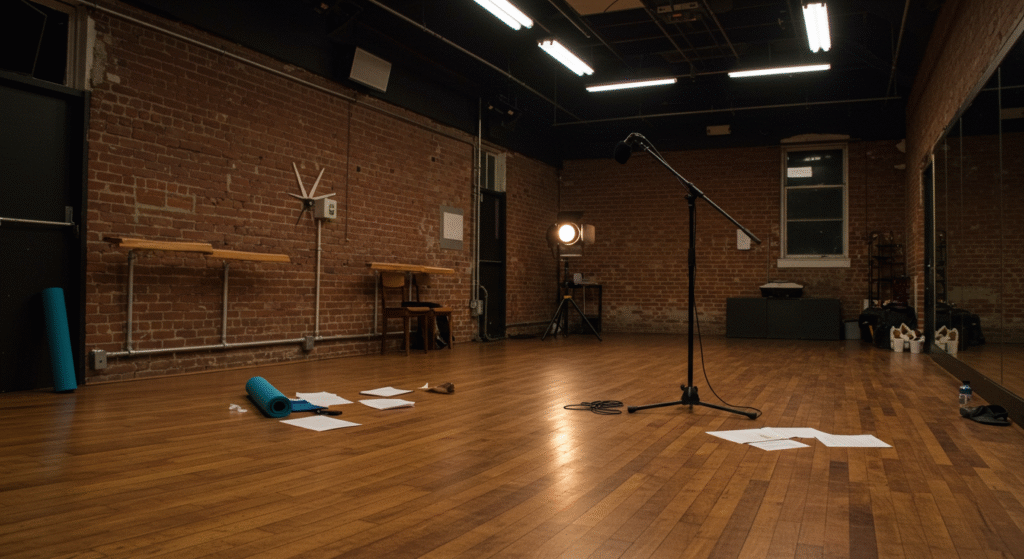
The routine below is designed for working professionals, drama-school students, and passionate hobbyists alike. You can run the whole sequence sequentially or scatter workouts throughout the day—during your commute, lunch break, or pre-audition warm-up. What matters is intention. Approach every repetition as a chance to refine micro-choices, release tension, and listen more deeply to yourself and imagined partners. Over weeks you’ll notice measurable gains: quicker text analysis, cleaner diction on self-tapes, more available emotion in class, and—most important—greater confidence that your craft is in your hands, not at the mercy of external circumstances.
For clarity, each exercise lists Goal, Time Needed, Step-by-Step, Useful Variations, and Common Pitfalls—plus a quick “Why It Works” note grounded in vocal science, movement research, or dramaturgical best practice. You’ll also find a one-page sample schedule near the end to help you weave the drills into real life without burnout. Pick up your metaphorical screwdriver and chisel; let’s start building.
Exercise 1 – Grounding Breath & Alignment Reset

Goal: Establish diaphragmatic breath, release postural tension, and connect mind to body before any other work.
Time Needed: 5–7 minutes.
Step-by-Step
- Neutral Stance: Stand hip-width, knees soft, feet parallel. Visualize a string pulling your crown upward while your tailbone drops.
- Body Scan: Starting at the scalp and moving downward, silently label sensations—heat in temples, tight jaw, slack shoulders—without judgment.
- Four-Six-Eight Breaths: Inhale through the nose for four, hold for six, exhale on a soft “f” for eight. Repeat five times, lengthening exhale if dizziness occurs.
- Rib Expansion Test: Place hands on your lower ribs. Inhale and feel 360° expansion; exhale maintaining spine length.
- Psoas Release: Gently rock pelvis forward and back, side to side, keeping breath fluid.
Useful Variations
- Semi-Supine Position: Lie on the floor with knees up and books under head to feel spinal length.
- Resistance Band Breath: Wrap a light band around ribs to provide tactile feedback on expansion.
Common Pitfalls
- Lifting shoulders to inhale (chest breathing).
- Locking knees, leading to lower-back tension.
Why It Works: Deep exhalation activates the parasympathetic nervous system, lowering cortisol and priming vocal folds for resonant vibration.
Exercise 2 – Vocal Resonance & Articulation Ladder
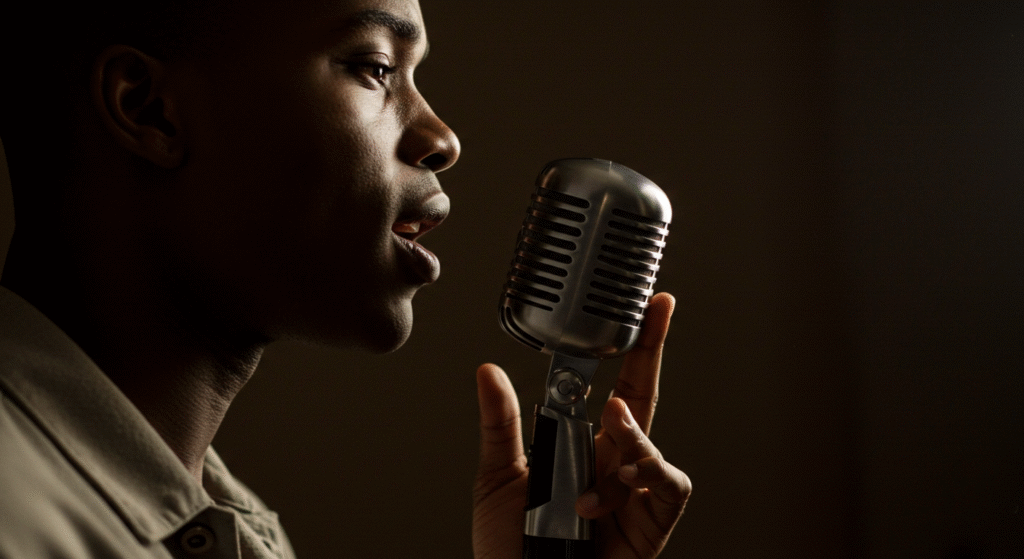
Goal: Warm and tune the voice across chest, mask, and head resonators while sharpening diction.
Time Needed: 8 minutes.
Step-by-Step
- Humming Glide: Start on comfortable mid-pitch, hum down to lowest note, then up to easy top. Feel vibration in sternum, lips, cheekbones.
- Lip Trill Sirens: Sustained trill from low to high and back, focusing on breath continuity.
- Consonant Pyramid: Speak “p-t-k-b-d-g / f-s-sh-v-z-zh / m-n-ng-l-r-y-w” increasing tempo without losing clarity.
- Resonance Placement Sentences: Say “Many moody murmurs” in chest voice, “Vivid velvet veils” in mask, “High honey harvest” in head.
- Articulation Ladder: Recite tongue-twisters ascending a step each line (e.g., crisp–crisper–crispest).
Useful Variations
- Record and play back to check unwanted sibilance or plosives.
- Add gentle neck and jaw massage between sets to reduce tension.
Common Pitfalls
- Forcing pitch extremes, causing vocal fry or strain.
- Dropping support on final syllables.
Why It Works: Alternating airflow exercises (trills) with consonant drills balances breath management and muscular precision, a combo proven to improve speech intelligibility in under four weeks.
Exercise 3 – Sensory Expansion Walk

Goal: Heighten awareness of sight, sound, touch, smell, and proprioception to feed richer moment-to-moment truth onstage or on camera.
Time Needed: 10 minutes (ideally outdoors).
Step-by-Step
- Single Sense Focus: Walk 60 seconds noticing only colors; label hues internally—brick red, slate gray.
- Layer Second Sense: Add sound; catalogue pitches, rhythms, distances.
- Progressive Stacking: Every minute include another sense until all five run concurrently.
- Memory Snapshot: Pause, close eyes, and mentally recreate the scene using all sensory channels.
- Return & Write: Jot a 100-word vivid paragraph; no metaphors, only raw data.
Useful Variations
- Reverse order (start with smell).
- Night-time version to emphasize temperature and ambient sound.
Common Pitfalls
- Judging stimuli (“too loud,” “ugly graffiti”). The task is observation, not critique.
Why It Works: Neuroscience shows that deliberate multisensory attention builds neural density in the insula and posterior parietal cortex—regions linked to empathy and spatial grounding, both vital for believable acting.
Exercise 4 – Emotional Palette Mapping
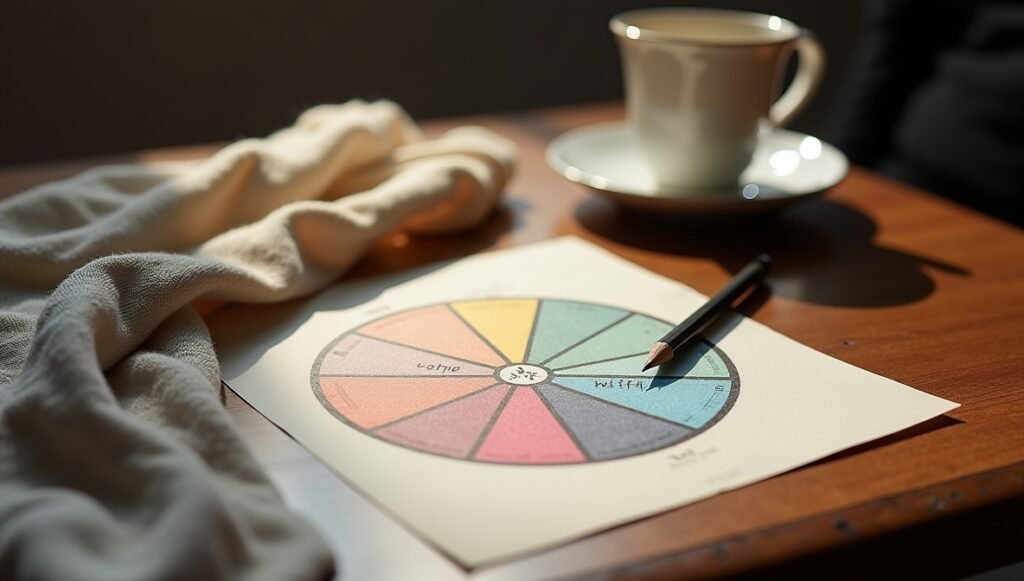
Goal: Broaden emotional availability by practising quick access to nuanced feelings without dredging trauma.
Time Needed: 6 minutes.
Step-by-Step
- Wheel Selection: Print a 36-emotion wheel. Randomly point to one (e.g., wistful).
- Image & Impulse: Let a neutral image arise—a cracked teacup—and allow body shift (shoulders soften, breath shallow).
- 30-Second Embodiment: Fully experience the feeling; speak a single improvised line in that state.
- Shake-off Reset: Three releasing breaths, limb shake, neutral posture.
- Repeat x4: Choose contrasting emotions (e.g., anticipation, resignation, glee, dread).
Useful Variations
- Partner Version: Partner names the emotion; you inhabit then name a spontaneous verb (“to reach,” “to retreat”).
- Music Trigger: Shuffle playlist; let unknown track dictate emotion.
Common Pitfalls
- Over-intellectualizing (“What would sadness look like?”) instead of letting physiology lead.
- Staying in a dark state post-drill—always reset.
Why It Works: Short bursts prevent emotional flooding while training the amygdala to transition rapidly—mirroring real rehearsal demands.
Exercise 5 – Active Text Analysis Drill

Goal: Transform cold words into playable actions quickly—a must for auditions and table reads.
Time Needed: 12 minutes (using a new scene daily).
Step-by-Step
- Read Aloud Once: Note instinctive beats without pausing.
- Underline Verbs: Circle two tactic verbs per speech (e.g., to charm, to needle).
- Five W’s Flash Cards: Who, what, where, when, why—write one-line answers.
- Oppositional Reading: Deliver the scene with the opposite tactics to test flexibility.
- Commit Take: Choose best tactics, read again at full stakes.
Useful Variations
- Timer Challenge: Limit entire process to five minutes to simulate callback pressure.
- Color-Coding: Highlight shifts in objective (yellow) and obstacle (pink) for visual learners.
Common Pitfalls
- Starting with emotion instead of objective—makes choices soggy.
- Treating punctuation as breath marks rather than clues to thought rhythm.
Why It Works: Action-verb analysis is rooted in Stanislavski-via-Uta-Hagen methodology, aligning cognition (objective) with behavior (tactic) for playable choices.
Exercise 6 – Physical Objectives Improv

Goal: Marry intention to body by pursuing a concrete task under imaginary circumstances.
Time Needed: 8 minutes.
Step-by-Step
- Prop Selection: Pick a household object—scarf, mug.
- Given Circumstance: Decide “The scarf burns my skin until I return it to its owner.”
- Silent Pursuit: Without words, act until the physical objective is fulfilled.
- Replay with Text: Add one memorized Shakespeare or Pinter line, letting physical stakes inform delivery.
Useful Variations
- Partner Creates Circumstances; you discover objective mid-improv.
- Restrict movement to a chair—forces micro-actions.
Common Pitfalls
- Pretending instead of believing: the object must matter viscerally.
Why It Works: Linking objective to tactile stimulus increases motor-cortex activation, embedding intention in muscle memory.
Exercise 7 – Status Flip Scenes

Goal: Master power dynamics—raising or lowering status through subtle behavioral cues.
Time Needed: 10 minutes (pair exercise; solo version provided).
Step-by-Step (Pair)
- Neutral Scene: Read a mundane dialogue (ordering coffee) at equal status.
- Assign Hierarchy: Person A high, B low. Replay noticing eye contact length, space usage, tempo.
- Instant Flip: Without resetting, switch status mid-scene on a keyword.
Solo Version: Recite monologue twice: first as sovereign, second as servant—altering breath placement, gesture size.
Useful Variations
- Mask Work: Wear neutral masks to shift focus from facial expression to posture.
- Camera Drill: Film both takes; study micro-differences in chin tilt, blink rate.
Common Pitfalls
- Confusing aggression with high status; genuine power often manifests in stillness.
Why It Works: Status training hones social calibration—vital for scenes in courtroom dramas, office comedies, or Shakespeare’s courts. Research in nonverbal dominance indicates that controlled gaze and economical movement signal authority more than volume or speed.
Exercise 8 – Subtext Monologue Layering
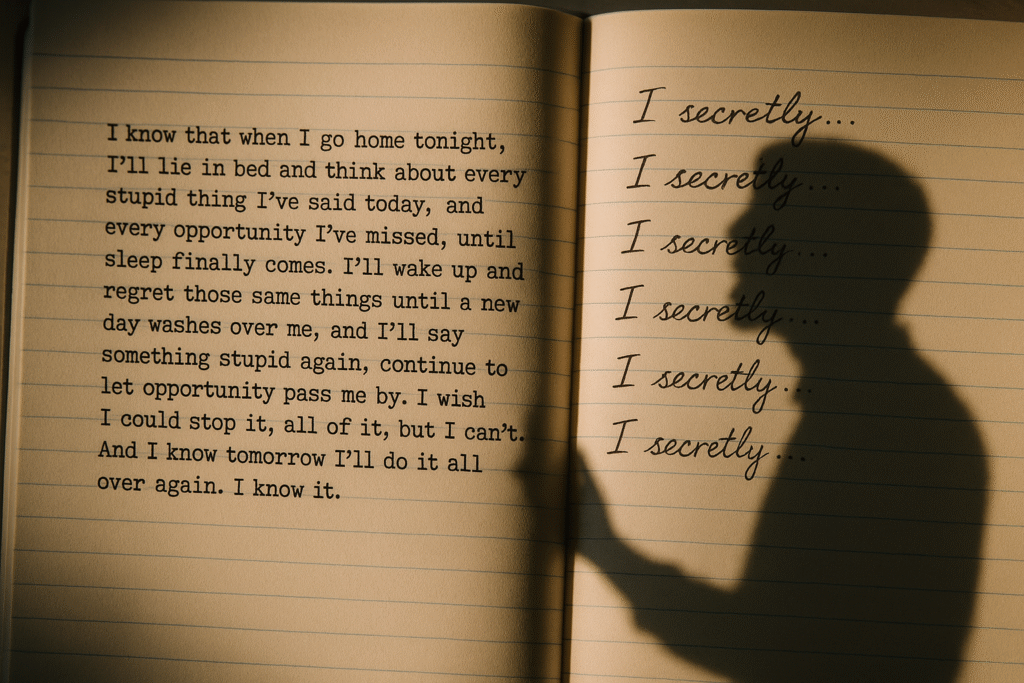
Goal: Cultivate the double voice—what a character says versus what they really mean.
Time Needed: 7 minutes.
Step-by-Step
- Choose 10-Line Monologue.
- Write Subtext: One sentence per line, starting with “I secretly…” (e.g., “I secretly beg you to notice me”).
- Speak Text Only: Out loud, focusing on factual content.
- Speak Subtext Only: Whisper or internalize.
- Fuse Layers: Deliver full monologue, letting subtext color tone, pauses, and emphasis.
Useful Variations
- Gesture Codex: Add a private gesture that matches subtext, then minimize gesture to micro-expression.
- Opposing Subtext Experiment: Replace with conflicting desire to explore irony.
Common Pitfalls
- Over-playing subtext until it becomes text; audience should feel tension, not receive exposition.
Why It Works: Psycholinguistics shows that micro-pauses and altered prosody convey hidden intent; practising them deliberately increases emotional nuance and audience engagement.
Exercise 9 – Cold Reading Countdown

Goal: Improve sight-reading, comprehension, and playable decision-making under time pressure.
Time Needed: 5 minutes.
Step-by-Step
- Grab Unseen Script Page (printing random sides from plays or TV).
- 60-Second Scan: Note genre, relationship clues, operative words.
- 30-Second Beat Mark: Pencil vertical lines for shifts.
- 15-Second Choice: Pick core objective and playable obstacle.
- One-Take Performance: Read to camera with full stakes.
Useful Variations
- Reduce total prep to 90 seconds.
- Partner gives redirection (“now play it like an apology”) then instant retake.
Common Pitfalls
- Neglecting punctuation rhythms—writers crafted them to guide breath and thought.
Why It Works: Mirrors real casting offices where you receive sides moments before audition; repeated exposure lowers cortisol spikes and boosts working-memory efficiency.
Exercise 10 – Self-Tape Snapshot

Goal: Refine on-camera truthfulness and technical polish by recording a 30-second slice daily.
Time Needed: 10 minutes (including review).
Step-by-Step
- Set Frame: Medium close-up, neutral background, soft key light eye-level.
- Deliver 30-Second Piece: Could be yesterday’s monologue or commercial copy.
- Instant Playback: Watch twice—first for performance, second muted for physicality.
- Single Note Fix: Choose one adjustment (eye-line drift, s-curved posture) and retape.
- Archive: Save both takes with date for progress tracking.
Useful Variations
- Use smartphone front camera for occasional “mirror effect” to check asymmetries.
- Add slate practising name, height, agency in one breath.
Common Pitfalls
- Tweaking lighting endlessly; remember the drill is performance not cinematography.
Why It Works: Micro-repetition of real audition conditions embeds camera-specific muscle memory—eye-line, framing awareness—reducing wasted takes when real opportunities come.
Integrating the Toolbox – Sample Weekly Plan
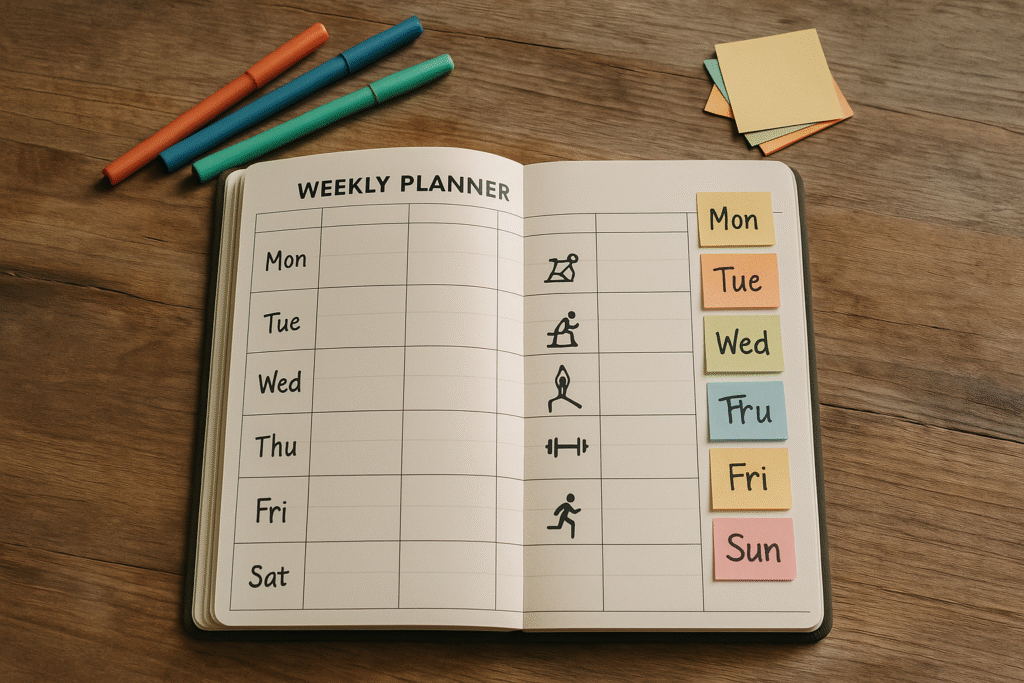
| Day | Focus Boost |
|---|---|
| Mon | Full sequence, emphasize Breath & Alignment + Vocal Ladder |
| Tue | Sensory Walk during commute; evening Self-Tape Snapshot |
| Wed | Emotional Palette + Physical Objective improv loop |
| Thu | Status Flip with partner; Cold Reading Countdown |
| Fri | Full sequence; archive best takes for agent review |
| Sat | 30-minute mash-up: Breath, Vocal, Text Analysis, Monologue Layering |
| Sun | Light maintenance: 15-minute stretch, reflective journal on week’s insights |
Adjust duration to fit rehearsal or shoot calls; the aim is consistency, not perfection.
Common Pitfalls Across the Toolbox
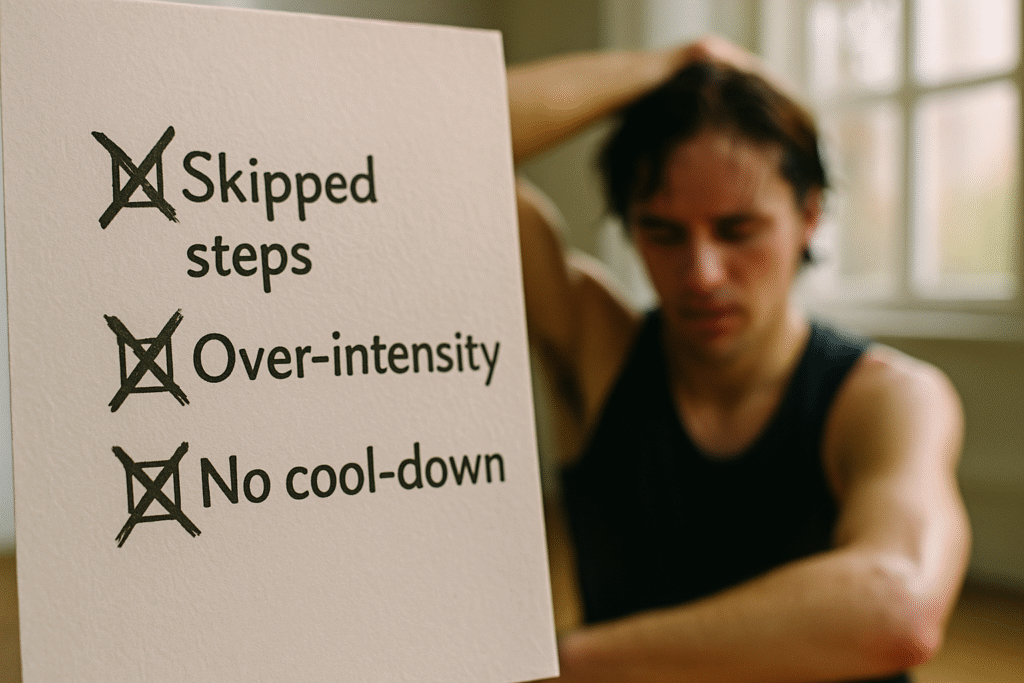
- Skimming Steps: Each micro-action primes the next. Skip one and cumulative benefit shrinks.
- Over-cranking Intensity: Daily drills should end with energy gained, not depleted. Dial back force; increase specificity.
- Neglecting Cool-Down: A two-minute stretch or meditation prevents residual tension, especially after emotional drills.
- Comparison Mindset: Progress is non-linear; measure yourself against your last week, not classmates or TikTok clips.
- Data Hoarding Without Reflection: Videos and journals are worthless unless reviewed for patterns—do a Sunday audit.
Further Resources
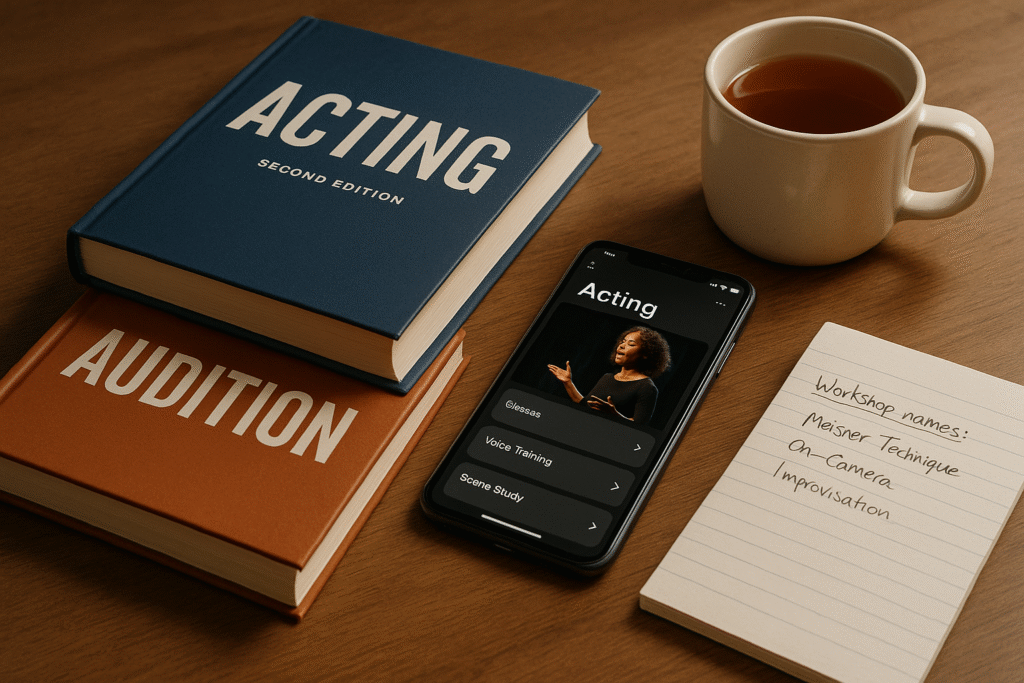
- Books: Freeing the Natural Voice by Kristin Linklater; Actions: The Actors’ Thesaurus by Caldarone & Lloyd-Williams.
- Apps: “Voice Tools” (spectrum visualizer), “PromptSmart” (teleprompter with voice-tracking) for self-tape lines.
- Online Communities: /r/Acting (Reddit) for script swaps; StageMilk’s “Daily Acting Challenge” Slack.
- Workshops: Knight-Thompson Speech intensive for advanced articulation; Viewpoints weekend labs for physical improv.
Curate, don’t collect—one great resource fully used beats ten unread PDFs.
Conclusion – Owning Your Craft One Day at a Time
Talent may open the door, but disciplined craft keeps you in the room. The ten exercises above are deliberately frugal—no expensive gear, no studio rental, no mystical guru required. They ask only for presence, curiosity, and a modest chunk of your day. Mastery is the accumulation of subtle adjustments: a millimeter more rib expansion, a half-tone smoother pitch glide, a fraction quicker objective decision. Stack those millimeters over weeks and you’ll feel seismic shifts in auditions and rehearsals.
Remember, the toolbox is living hardware. Customize it. On heavy shoot weeks, maybe Vocal Resonance and Self-Tape take priority; during theatre tech, Grounding Breath and Status Flips soothe nerves and sharpen stakes. Review your progress videos monthly, celebrate gains, and reset goals. Acting thrives on perpetual exploration; when drills start feeling automatic, tweak variables or swap in fresh material.
Make this routine a ritual as habitual as brushing your teeth. Not glamorous, not instantly Instagram-worthy—yet quietly transformative. Show up daily, and when opportunity knocks, you’ll answer not with hope but with a ready instrument tuned to truth.

